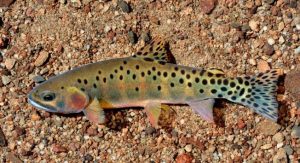
Rio Grande cutthroat trout Photo by US Fish and Wildlife
GREAT SAND DUNES NATIONAL PARK — Rangers at Great Sand Dunes are fighting to save the population of Rio Grande cutthroat trout within its borders, according to Park Resources Manager Fred Bunch.
The fish has seen serious population decline in the southwestern part of Colorado after invasive Brown and Rainbow trout push cutthroats out of their native waters. Experts estimate cutthroats only occupy 15 percent of their historic range around the southern Rockies.
The Great Sand Dunes is a nearly bone-dry expanse with only two streams, Medano and Sand Creek, flowing intermittently through the park. These streams are isolated refuges for the native trout, according to Bunch.
“Water is more valuable than whiskey here,” says Bunch. Even so, private landowners on the east side of the Sangre de Cristos divert almost 50 percent of Medano creek in peak flow season of June and July.
Some of the fish follow the water diverted from the creek. When the diversion ditch is closed in July, the fish flop and asphyxiate in the suddenly dry bed. Park employees Bunch and Andrew Valdez walk the ditch with buckets in hand and manage to save about 40 fish by hand every year. Many more still perish.
To save the fish in Medano, the park considered buying the private land and its water rights where the diversion occurs, but to no avail. They also requested a water wheel be placed at the site of the diversion to stop the fish, a request which is yet to be fulfilled by the owners of the property.
In nearby Sand Creek, in the north of the park, rangers attempt a radical approach to curb non-native species. They want to create a clean slate for the native fish to thrive, according to Bunch. To do this, they first erase bag limits of any kind for fishing in the creek. Fishermen are encouraged to take home as many of the invasive Brown and Rainbows as they can.
“We don’t want food to be wasted” Valdez said. The park employees then use small doses of the poison Rotenone to wipe out any remaining aquatic life.
Because the creek ends in evaporating puddles in the desert below, there is no worry for poisoning any major waterways, according to Valdez. Park employees then will re-introduce the native cutthroat into Sand creek without worry of competition from non-native species.
Bunch dreams for the park to be a timeless corner of the world, seemingly unaffected by humans. But in order to make a pristine, natural area of land, thriving with native species, it requires a lot of work, resourcefulness, and fish poison.

